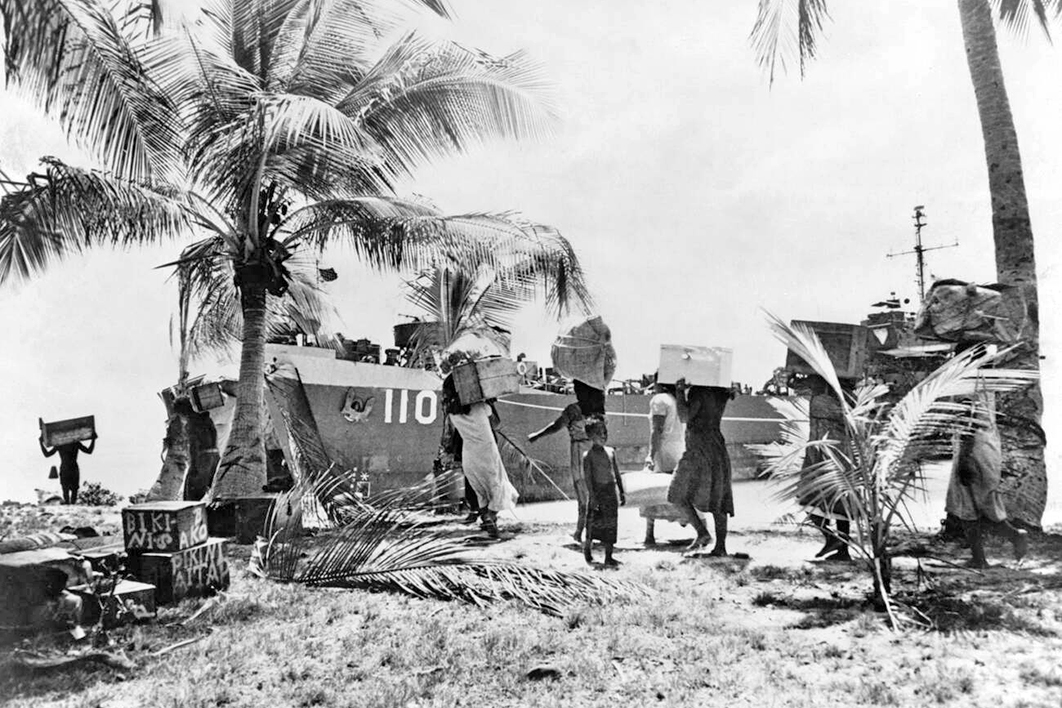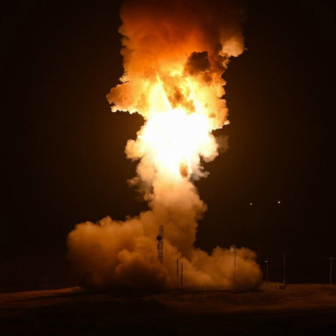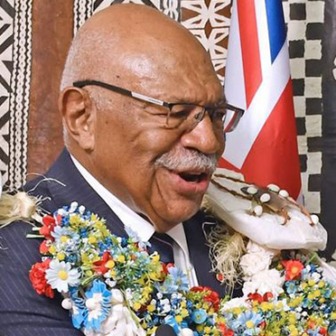Between 1946 and 1958, when the Marshall Islands was still administered by the United States under a UN strategic trusteeship, the American military conducted sixty-seven atmospheric nuclear tests at Bikini and Enewetak Atolls. During and after the tests, military scientists conducted medical experiments on Marshall Islanders, often without their full, prior and informed consent. The health and environmental effects of the nuclear detonations and experiments linger to this day.
After the Marshall Islands entered into a compact of free association with Washington in 1986, its new parliament, the Nitijela, created a Nuclear Claims Tribunal to adjudicate claims for compensation for health and environmental legacies. Over the next twenty years Marshallese survivors and scientific experts provided the NCT with detailed information about the nuclear era and its impacts.
By the time the NCT began winding up in 2010, its judges had awarded a total of US$2.3 billion in compensation for property damage, loss of land use, personal injury, hardship and suffering, as well as for clean-up of contaminated lands. But the trust fund set up under the 1986 compact, with Washington’s one-off injection of US$150 million, fell well short of that figure. To this day, hundreds of millions of dollars of compensation remains unpaid.
That could have been the end of the story, but for a provision in the 1986 compact. The Marshall Islands government, says the compact, can seek further funding for nuclear legacies if it can demonstrate “changed circumstances.” Circumstances have changed, and that change came from an unexpected quarter: new archival material transferred from Washington to the Marshallese capital, Majuro, in the mid 1990s.
The cache of new material not only threw new light on the scope of the nuclear tests and their effects but also highlighted the importance of archival material for poorer countries seeking restitution for past injuries. In the Marshall Islands case, it came with an extra message: the need to preserve the archives assembled by the NCT over its two decades of operation, which were at risk of neglect and decay.
In December 1993, soon after the collapse of the Soviet Union, US energy secretary Hazel O’Leary announced the scheme that would help the Marshallese. Under the Clinton administration, O’Leary’s Openness Initiative aimed to increase transparency by opening up the United States’ cold war–era nuclear archives to scrutiny. Among the material to be made available would be many of the documents held by institutions involved in developing and testing nuclear weapons.
In March 1994, the Clinton administration created the Office of Human Radiation Experiments, or OHRE, to collate and release evidence of radiation research using human subjects during the second world war and the cold war. OHRE identified and catalogued documents drawn from 3.2 million cubic feet of archival records scattered across the United States. By the end of 1997, it had declassified more than ten million pages, including many records covering the Marshall Islands.
The US Department of Energy then released to the Marshall Islands government more than seventy boxes of newly declassified documents. They revealed that the spread of radioactive fallout from the 1954 Bravo test, as well as from other atmospheric tests that year, was much wider than previously acknowledged.
As one example, a US Atomic Energy Commission report from January 1955, “Radioactive Debris from Operation Castle, Islands of the Mid-Pacific,” listed two dozen islands and atolls in the Marshalls that received varying levels of fallout from all six of the 1954 hydrogen bomb tests at Bikini Atoll.
The study shocked Marshallese leaders. For nearly forty years the US military had hidden documentary evidence showing fallout from the Bravo test series spreading across more than 11,000 square kilometres. Plumes of contamination had affected virtually every atoll in the island nation — not just the northern atolls close to the Bikini test site.
When I met then Marshallese president Dr Hilda Heine in Majuro in 2017, she told me these documents confirmed that eighteen other inhabited atolls or single islands had been contaminated by the tests. “The myth of only four ‘exposed’ atolls of Bikini, Enewetak, Rongelap and Utirik has shaped US nuclear policy on the Marshallese people since 1954,” she said, “which limited medical and scientific follow-up and compensation programs.”
It’s little surprise that the Openness Initiative was shuttered within a few years. In Restricted Data, his history of US nuclear secrecy, researcher Alex Wellerstein explains that Hazel O’Leary’s campaign for accountability and transparency was short-lived because openness “was increasingly seen as a political liability that had mollified few critics and drawn lots of attention to past misdeeds.”
As the shutters came down, documents about the testing program at Bikini and Enewetak Atolls began disappearing from the US Department of Energy website. In response, Wellerstein established a mirror site, the Marshall Islands Nuclear Document Database, preserving public access to more than 13,700 official documents that would otherwise be buried in the archives.
Prospects for further transparency are dire. When the US Public Interest Declassification Board examined the feasibility of declassifying more Marshall Islands records last year, it concluded that any reopening of nuclear-era archives would take up to six years, would cost between US$100 million and $200 million, and would need around a hundred staff “who are fully cleared at the Top Secret and Q levels” and “trained to identify and review technical nuclear weapons data.”
NCT staff recognised the importance of the survivor and expert testimony given to the tribunal’s hearings in the 1990s and early 2000s. These witness statements, recorded on audio and video cassettes, are vital evidence for any future litigation, especially with many of the witnesses ageing, ill or dying. Preserved, the recordings would also serve as an irreplaceable historical asset for future generations. But the Marshall Islands lacked the staff, finance and archival facilities to protect the fragile recordings. Who could assist?
Enter Trudy Huskamp Peterson, an archival luminary from the United States. Peterson spent twenty-four years with the US National Archives, including a period acting as the US Archivist. Since leaving government service, she has worked as an adviser and consultant for many developing countries, including archival training with Truth and Justice Commissions in South Africa and Honduras, and the Special Court for Sierra Leone, and worked with human rights groups preserving police archives in Guatemala.
Over many years, she has tackled the conundrum facing governments around the world: how do you protect information for reasons of privacy or national security while holding the security state to account?
“You do have the impulse from the security agencies that everything has got to be locked up forever,” she tells me, “but you also have the real impulse from the public to see what the government is doing in our name. Without public pressure, you do not get things declassified.”
The security agencies are generally over-cautious, says Peterson. “When we’ve opened things over their objections, the sky in general hasn’t fallen. Governments need to come to the realisation that these things can’t be closed forever. There has to be a time set in which you let the documentation go out. If it makes the security services look bad, so be it! But this is a terrible conundrum in most societies that have a modern security network.”
Recognising that the Marshall Islands lacked the resources to protect memory and history, Peterson seized the opportunity to work with staff in Majuro. “When I first got involved in the Marshall Islands,” she tells me, “we found a number of videos and many audio recordings of hearings of the tribunal. They were in terrible shape, as they’d been sitting in tropical heat for years.”
She says that preserving physical material is a real problem for poorer countries, but protecting electronic records also has its challenges. “It isn’t that the principles of creating archives change from paper to electronic, but the techniques do. All the technical equipment and skills that you have to have are different. Most countries like Palau or Kiribati can’t afford that. Internationally, we don’t have a good answer to that challenge.”
Throughout this period, NCT public advocate Bill Graham was a driving force in the effort to preserve the tribunal’s records. A former teacher and lawyer who arrived in the Marshall Islands as a Peace Corps volunteer, Graham retained an encyclopedic knowledge of the nuclear testing era, until his untimely death in March 2018.
Drawing on Peterson’s global network of archivists, Graham found support for the project halfway around the world, in the Catalan municipality of Girona in Spain. Peterson was friendly with Joan Boadas i Raset, who has served as the Girona Municipal Archivist since 1990 and is one of the world’s leading audiovisual preservation specialists.
Girona has a large museum of moving images and hosts an international conference most years to discuss the preservation of audiovisual heritage. As director of the city’s Centre for Image Research and Diffusion, Boadas had the technology that could assist the NCT. With some prodding from Trudy Peterson, he agreed to assist.
“I was sitting across the table from Joan at dinner one night,” she explains. “I said to him, ‘Let me tell you about this problem that I’ve got. Would you consider taking these materials in, cleaning them up, making a digital copy, then holding a copy and giving the originals back to the Marshall Islands?’ He said, ‘Yeah, I can do that’ and we shook hands across the table.”
The Marshall Islands government and the municipality of Girona signed an agreement in October 2012, agreeing to digitise and store irreplaceable NCT documents along with seventy-five videos and 428 cassette recordings. Bill Graham, travelling to a human rights conference in Geneva, took a suitcase filled with video and cassette tapes across the borders of the United States, Switzerland and Spain.
Staff at the Municipal Archive of Girona, known as AMGi, began work the following year to digitise the records — work donated by the city at no cost to the Marshall Islands government. At the time, the mayor of Girona was the Catalan politician Carles Puigdemont i Casamajó, a champion of self-determination and independence for the Catalan people. (Today, Puigdemont lives in exile, after Spain issued charges of rebellion, sedition and misuse of public funds against him and other independence activists who had overridden rulings by the Constitutional Court of Spain and organised a referendum on self-determination.)
For Joan Boadas, the role of the archivist is to recognise the power of memory: “Power for the benefit of administration and, therefore, institutions, businesses and people’s rights. Power to preserve memory. Power to avoid forgetting and, also, power itself because documents, archives, are an extraordinary tool for the future.” His centre returned the original documents along with hard drives of the digitised material to Majuro in early 2017.
Trudy Peterson then turned to another task: to find a third country that could safely store a copy of the Marshallese records in perpetuity.
“Most countries don’t want another institution holding important records,” she said. “But if you’re going to go underwater or the climate is so inhospitable, then getting a digital copy out is better than nothing. When we set out to find a safe haven for the Marshallese records, we probably could have found one in the United States. But that was the last place anyone would want those records to be stored, because they were the perpetrators of the nuclear testing.”
She turned to Switzerland, and obtained a grant from the Minister of Foreign Affairs to digitise key documents. Once again, she drew on her global network to find a Swiss non-government organisation to help NCT staff scan and save documentary records.
SwissPeace has a record of seeking safe havens for records, she says, whether the danger is from war, revolution, civil unrest or climate change. “That’s certainly the case for the Marshall Islands and probably for many other small island states in the Pacific and Caribbean,” says Peterson. “If you want to make a security copy to take outside the nation in danger, you have to make a copy first. But in general, in many cases, you don’t have a way of getting those records digitised in the first place.”
SwissPeace now administers a grant from the Swiss Federal Department of Foreign Affairs to preserve the records in perpetuity. “Working out this process with Swiss lawyers, for whom every comma and semi-colon has three meanings, was extraordinarily difficult,” Peterson laughs. “What can you see if you are a nuclear victim, or the victim’s lawyer, or a trustee? If you are an academic researcher, what can you access? If you’re a medical researcher, can you look at medical records but promise not to reveal people’s names? All of these kinds of questions had to be discussed laboriously between the two parties. We had to determine what would be restricted, and for how long, and who could have open access.”
In March 2016, the Marshall Islands Nitijela passed a resolution thanking the city and people of Girona, recognising “that the outstanding skills, talents and dedication involved in digitising and preserving the records of the Tribunal constitute a gift of inestimable value and serve to ensure that a major part of the documentation of the legacy and effects of nuclear weapons in the Marshall Islands will endure and not be lost or forgotten.”
Accepting an award for his archival work in 2022, Joan Boadas declared that “documents are the stuff of memory, even in this age of intangibility. One could even say that they are memory’s memory.”
He went on: “Are we to be in favour of amnesiac amnesties in the face of aggressive violations of human rights? Or should we go to the archives and the documents to find out what happened, who was responsible, who suffered the consequences and, from there, open up to reconciliation? If you like, it is as simple as this: documents allow forgiveness, but also prevent forgetting.” •




